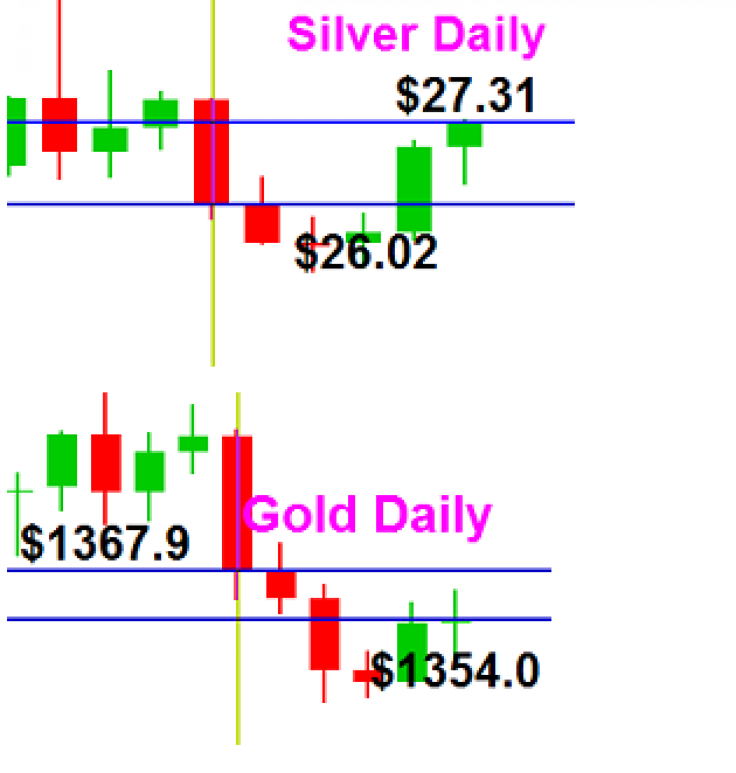PRECIOUS ROUNDUP - Silver, palladium post weekly gains; gold, platinum down

In an eventful week, that passed through uncertainty about Ireland's response to a bailout offer, an unexpectedly higher Chinese inflation number and its policy response and largely mixed US data, investors remained cautious about the changing 'risk-friendliness' of commodities. Silver and palladium closed the week higher while gold and platinum completed their second straight week of losses.
On and off, risk appetite kept playing
Investors were naturally cautious about going further long on the precious metals which had either rose to record levels or visited fresh multi-decade highs in the previous week.
When inflation data from China warned about an imminent rate hike by the dragon, commodities fell across the board and dollar gained. Later, when US data showed core inflation fell to its lowest on record in October, the greenback plunged and commodities rose as investors feared more easing by the Fed.
When market was uncertain if Ireland would accept an EMU help offer to pay off its sovereign debt, they sold off euro, thereby helping the US dollar and punishing commodities. Then as the Irish authorities finally said they will take the help, things reversed but only to turn around at the end of the week as Chinese resurfaced.
The dollar strengthened against the euro as much as 1.82 percent to 1.3446 during the week but ended Friday at 1.3684, just 0.05 percent higher in the week.
Gold and platinum down, but long-term outlook bullish
Both the metals delivered almost equally through the risk-on, risk-off days and despite the current bullishness in dollar, which is mainly supplied by weak-commodity outlook due to fears of China's cooling, the precious metals are expected to remain safer investment avenues in the longer term as the US is still not out of woods.
Ben Bernanke, the Federal Reserve chairman, said in a central banker's meeting on Thursday that what he did in terms of quantitative easing (QE) was appropriate.
Reading into Bernanke, market participants say that Thursday's lower-than-expected rise in jobless claims and a pick-up in housing starts as shown earlier in the week may not be considered reasons strong enough to rule out further quantitative easing by the US. The core inflation number at its lowest since recording started in 1957 to support supports their stance.
Spot gold fell as low as $1,329 an ounce in the week to November 19 before bouncing back to $1,353 by the end of Friday but was still 1.12 percent below last Friday's close of $1,368.39. It is now 4.8 percent weaker than the record $1,424.1, touched on November 9.
Spot platinum ended Friday at $1,664.5 per ounce, moving off the week's low of $1,623.0 but down 0.86 percent from last week's close of $1,679. The metal is now down by 7.9 percent from its record level of $1,806.5 hit last week.
Extra boosters for silver and palladium
Silver and palladium were more volatile through the recent months compared to the rest in the precious group, probably aided by additional supports like big players' suspected need to cover short positions in the case of silver while strong demand-supply fundamentals helped palladium.
Both the metals are of relatively more industrial importance compared with gold and platinum. Palladium, mainly produced by Russia and South Africa, is expected to see a sharp reduction in inflows from Russia by next year and the supply concerns had helped the metal rise more than 72 percent from end-2009 level of $405.5 per ounce.
The metal for immediate delivery ended Friday November 19 at a 1-week high of $699.72, up 0.82 percent on the day and 4.36 percent stronger than previous Friday's close. Silver also ended Friday at a one-week high of $27.32, up 1.52 percent from Thursday and 5.04 percent higher from November 12 close.
China concerns to dominate market talks early next week
In response to the consumer price inflation that jumped to its highest in 25 months in October, People's Bank of China (PBoC) on Friday asked banks to keep more cash aside, cutting their lendable resources. However, most analysts said the liquidity-targeted policy response would not really bring down credit growth in the country.
The 50-basis-point hike in the reserve ratio is estimated to soak up liquidity of up to 350 billion yuan ($52.7 billion) and follows PBoC's October policy tightening of 25 basis points.
Wang Tao, head of China research at UBS Securities, said the increase of foreign reserves in China would impose more liquidity pressure on the market. The reserves might reach $80 billion in October because the trade surplus amounted to nearly $27.2 billion, which is more than a 60 percent increase from the previous month, UBS said.
M2, the broad measure of money supply, rose 19.3 percent in October from a year earlier. China lent out a more-than-expected 587.7 billion yuan in October, which is also expected to increase the liquidity pressure.
Investors across the globe are now waiting for fresh signals from the world's second largest economy as to when it will raise its benchmark lending rate, before deciding whether to buy, sell or hold their commodity stakes.

© Copyright IBTimes 2024. All rights reserved.











